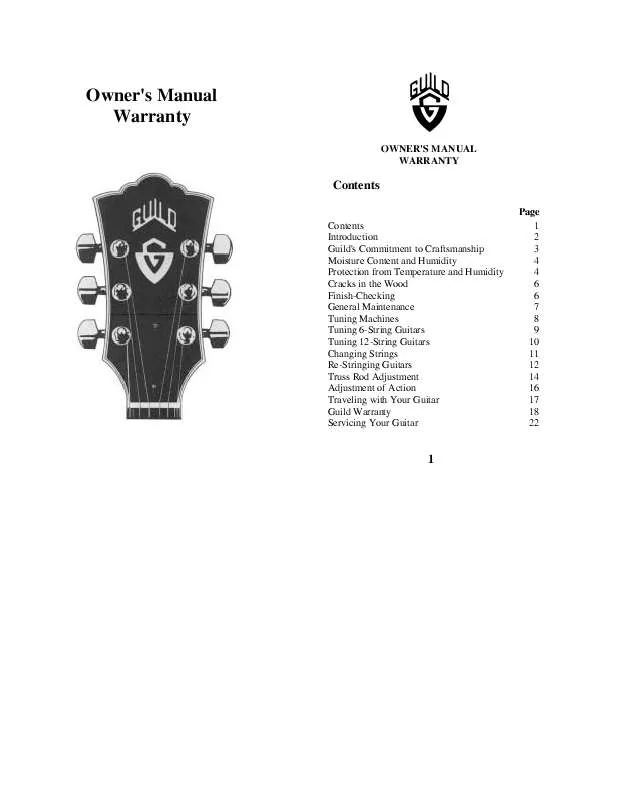Detailed instructions for use are in the User's Guide.
[. . . ] Owner's Manual Warranty
OWNER'S MANUAL WARRANTY
Contents
Page 1 2 3 4 4 6 6 7 8 9 10 11 12 14 16 17 18 22
Contents Introduction Guild's Commitment to Craftsmanship Moisture Content and Humidity Protection from Temperature and Humidity Cracks in the Wood Finish-Checking General Maintenance Tuning Machines Tuning 6-String Guitars Tuning 12-String Guitars Changing Strings Re-Stringing Guitars Truss Rod Adjustment Adjustment of Action Traveling with Your Guitar Guild Warranty Servicing Your Guitar
1
Introduction
Thank you for choosing a Guild. We believe this new instrument will give you many years of pleasure. Please take a few moments to read through this booklet. In it you will find answers to many of your questions and other invaluable information about care and maintenance for your guitar.
Guild's Commitment to Craftsmanship
Guild was established in 1952 by Alfred Dronge. [. . . ] Always tune from below pitch, up to the correct pitch instead of down from a higher pitch. This will help eliminate string slack from the tuning machine and decrease the possibility of slippage and tuning changes as you play. The strings should be tuned as follows, starting from the thickest string to the thinnest: E, A, D, G, B, E. If you have an acoustic guitar use the A-440 reference tone on your tuner, a guitar pitch pipe, an A-440 tuning fork or other pitch reference, and tune the second string, "A" to pitch. Then, depress the second, or "A" string at the 5th fret, to produce a "D", and tune the "D" string to that same pitch. Next, depress the D string at the 5th fret, to produce a "G", and tune the "G" string until the pitches match. Next, depress the "G" string at the 4th fret, to produce a "B", and tune the "B" string until the two pitches match. Next, depress the "B" string at the 5th fret, to produce an "E" and tune the thinnest string to a matching "E". Finally, go back and play the thickest "E" string and tune it until the pitch at the 5th fret, an "A", matches the "A" on the adjacent string. If using an electronic tuner on your electric or acoustic/electric, simply plug in your guitar, turn the volume up and tune from low strings to high as noted on the tuner: E, A, D, G, B, E.
8
9
Tuning 12-String Guitars
Due to the tremendous amount of tension exerted on the neck by the 12 strings, we suggest that you use a light gauge string set, such as the Guild XL-1000 or L-1250 on your 12-string guitar. In standard 12-string tuning, the second string in each pair is tuned to the same pitches, E, A, D, G, B, E, and using the same methods as the six string guitar on the previous page. For the E, A, D, and G strings, the first smaller string in each pair is tuned to the same note, but an octave higher in pitch than its partner. For the B and E strings, the first string in each pair is tuned in unison, (exactly the same pitch), as its partner string. Many players find it difficult to press the strings down on a 12-string, due to the high tension caused by the extra strings. A remedy that some players choose is to tune the entire guitar to a lower relative pitch, such as E-flat or D; thereby reducing the string tension. You may then use a capo on the first or second fret, to bring it back up to where it plays at standard pitch. The guitar will certainly be easier to play, and the reduced tension will put less stress on the neck over time, but bear in mind that it will also sacrifice a bit of the tone projection of the instrument. All Guild 12-strings feature a double truss rod system for superior strength and improved accuracy with the adjustments, however, a 12-string tuned at standard pitch, should be monitored regularly for the possible need of truss rod adjustments. A guitar in need of an adjustment that is ignored may develop permanent problems. (See page 14. ) Please Note: Warpage of the neck, caused by the neglect of necessary adjustments will not be covered under the Guild warranty.
Changing Strings
A new set of strings can breathe renewed life into your instrument. That is why many "tone-conscious" touring professionals change their strings before every performance. While there is no set rule on how often to change strings, we have found that most players do not change them nearly as often as they should. [. . . ] Setups, adjustments or routine maintenance of any kind. Damage to finishes or cracks, splitting, or warpage of wood due to changes in temperature or humidity, exposure to or contact with sun, fire, moisture, perspiration, body salts and acids, guitar straps, guitar stands/hangers made from vinyl, plastic, rubber or other synthetic materials, any other chemicals or non-Fender-approved polishes. Damage, corrosion or rusting of any hardware components caused by humidity, salty air, or exposure to the moisture, body salts and acids of perspiration.
18
4.
19
5. Any damage to an instrument resulting from 6.
customization or modification. [. . . ]


